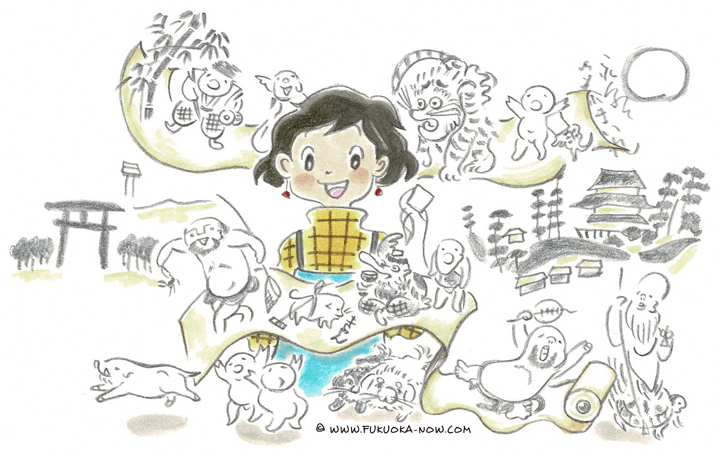Hakata Culture vol.152
A Zen Monk Known for Playful Ink Paintings

Sengai Gibon (1750-1837) was a Zen monk who left behind a plethora of playful ink paintings, the most famous of which is just a circle, a triangle and a square (“○△□;” referred to in English as “The Universe”). Many of his other works look like people and animals drawn by children and resemble today’s cutesy yuru-chara mascots. Sengai, active in the Edo era, spent the latter half of his life as the abbot of the storied Shofukuji Temple. In addition to his paintings, he also left behind many humorous works of calligraphy and haiku poems.
Sengai was born in Mino Province (now Gifu Prefecture) in 1750 and became a monk in the Rinzai school of Zen Buddhism at the age of 11. After traveling throughout Japan on foot, he ended up in Hakata at the age of 39, and after becoming a monk at Shofukuji Temple, he remained in the city for the rest of his life. He is said to have only picked up the brush in his late 40s, but he left behind more than 1,000 paintings and works of calligraphy by the time he passed away in 1837 at the age of 88.
Sengai was a popular figure in Hakata, especially with children, because, like his paintings, he was approachable and light-hearted. His reputation preceded him, and people were constantly asking him for paintings. Because people used to bring pieces of paper for Sengai to draw on, he wrote the following humorous poem:
“To my dismay
I wonder if my small hut
is just a toilet
since everyone who comes here
seems to bring me more paper!”
One of Sengai’s early yuru-chara-esque paintings now serves as the mascot of the Fukuoka City Art Museum. Many of his works are in storage at the museum, and from those, several mascot-like figures were selected and used to make decorative towels, Hakata dolls and other items for the gift shop. Be sure to check them out along with his works on display in the exhibition room.
ユニークな絵が評判の禅僧・仙厓さん
「○△□」の図形だけを描いた禅画、子どものいたずら書きのような人物や動物たち。今でいう「ゆるキャラ」を思わせるユニークな絵を数々残した仙厓義梵(せんがいぎぼん)。博多の名刹・聖福寺の住職を長く務め、「博多の仙厓さん」として親しまれた江戸時代の禅僧です。絵だけでなく書や俳句もたくさん残し、いずれもユーモラスなものばかりです。
1750年に美濃国(岐阜県)に生まれた仙厓さんは11歳で臨済宗の僧となりました。その後は全国行脚の旅に出て、博多にやってきたのは39歳のときです。聖福寺のお坊さんになって以降はずっと博多に住み続けました。本格的に絵を描き始めたのは40代後半からといわれており、1837年に88歳で亡くなるまでに1000点以上の絵や書を残したとされます。
仙厓さんは画風と同じく親しみやすい人柄で、博多の人たちに慕われ、子どもたちにも人気がありました。また、生前から評判の高かった絵をねだる人が絶えなかったといいます。皆、絵を描いてもらうために紙を持って訪ねてくるので、「うらめしや わがかくれ家は雪隠(せっちん:トイレのこと)か 来る人ごとに紙おいてゆく」と狂歌を詠んでいます。
最初に「ゆるキャラ」のような絵と書きましたが、今では実際に福岡市美術館のキャラクターになっています。福岡市美術館は仙厓さんの書画を多数収蔵しているのですが、その作品の中から抜け出たキャラクターたちが手ぬぐいや博多人形、変わったところではガムにもなっているのです。展示室に飾られた作品とともに、ショップのアイテムもチェックしてください。

